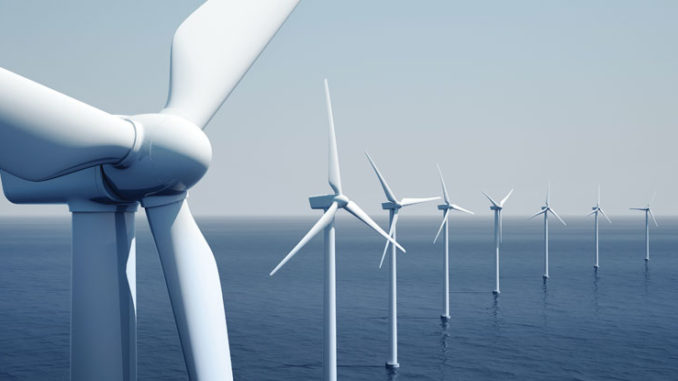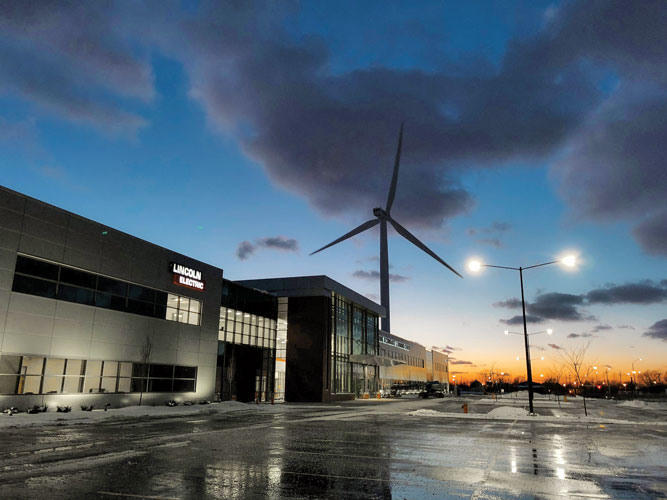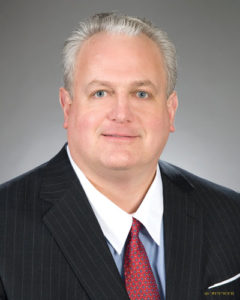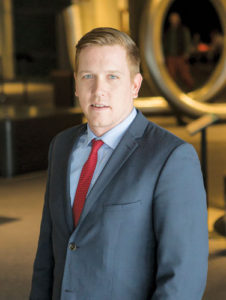
There’s a windstorm brewing off Lake Erie and Mother Nature can’t be blamed
By Jill Sell

Icebreaker Wind is an offshore demonstration project consisting of six wind turbines to be built 8 miles north of Cleveland in Lake Erie. Each turbine is 479 feet tall with its lowest point of the blade 65 feet above the water. If the project is approved, grid connection will be made by underwater cable to a Cleveland Public Power substation. It would be the first offshore wind energy project in the Great Lakes.
The $126 million, 20.7-megawatt (MW) project has been called everything from an answer to northern Ohio’s economic woes to a major disaster in the making. Proponents and opponents are huffing and puffing over environmental issues, value and cost of the energy generated, tourist dollars, property values, foreign investment, number of jobs created and more.
Icebreaker’s developer is the Lake Erie Energy Development Corp. (LEEDCo), an organization established in 2009. Members include the City of Cleveland, Port of Cleveland and the Cleveland Foundation, as well as Cuyahoga, Ashtabula, Lake, Lorain and Erie (Pennsylvania) counties. LEEDCo has the financial backing of Fred. Olsen Renewables, a wind energy project developer headquartered in Norway. That global company formed a subsidiary, Icebreaker Windpower, Inc., based in Cleveland.
The Ohio Power Siting Board (OPSB), which has final approval over the project, most recently met in August to review what LEEDCo’s vice president of operations, Dave Karpinski, said were “clarifications” of 34 stipulations of the initial Icebreaker proposal. Karpinski anticipates a decision to approve or sink the wind turbines in December. Last year, the Feds—the U.S. Department of Energy (DOE), the U.S. Coast Guard and the U.S. Army Corps of Engineers—signed off on an Environmental Assessment conducted by CH2M (now part of Jacobs Engineering Group), an environmental consulting company.
But that assessment is a tempestuous topic. In question are the lives of millions of migratory birds, bats, fish, insects and other wildlife. The Black Swamp Bird Observatory, an internationally known avian research and educational facility in Oak Harbor, objects to the project because the selected turbine site is in the Central Basin of Lake Erie, a National Audubon Society designated Globally Important Bird Area. According to the observatory, more than 300 species of birds use the area for migration and foraging each year.

LEEDCo acknowledges a low collision risk of “nocturnally migrating songbirds and similar birds” as they migrate across Lake Erie. The danger risk for eagles and raptors is also low, according to LEEDCo’s environmental document. LEEDCo says it will not install lighting on its turbines that attracts birds.
Lake Erie also provides drinking water to 11 million people, recreational opportunities, a respected commercial fishery and much desired lakeshore real estate. The Great Lakes provide 20 percent of the world’s fresh water. LEEDCo says Icebreaker would be the first freshwater project in North America. Karpinski also says it could establish “Cleveland as a leader in offshore wind power,” attracting and retaining young talent who feel sustainable energy is important. The project, he says, will create jobs (although opponents and proponents cannot agree on how many) and locally generated clean power.

But not everyone agrees turbines in the lake are worth the price, and the stakes are high. John Lipaj is a board member of the nonprofit Lake Erie Foundation (LEF), an advocate for a healthy Lake Erie. LEF, the U.S. Fish and Wildlife Service and other groups have called for an Environmental Impact Statement, a more in-depth study used for projects that have potential for great changes. Karpinski claims there is no need because the initial assessment showed no significant concerns.
However, money for the assessment came from funds DOE allotted to LEEDCo for the project, an allowable action. Also the DOE says it “utilized data from a variety of sources, including LEEDCo and from subject matter experts hired by LEEDCo.” Those actions created an ill wind with some Icebreaker opponents. However, DOE claims “while LEEDCo provided technical information…the DOE is responsible for the scope and content of the environmental assessment.”

“There is no question most Clevelanders are not really aware of Icebreaker or its intent,” says Norm Schultz, Lake Erie Trades Association president emeritus, representing boating clubs, boating enthusiasts and boat dealers. “This is a proposal that could have an enormous impact on Lake Erie now and for generations to come. It commands the utmost analysis and the Environmental Impact Statement would be that effort.”
Karpinski called that demand “a delay tactic.” LEEDCo is looking at potential tax credits as well as a December 2022 deadline for Icebreaker to provide electricity to the grid or forfeit a $40 million DOE grant. If Icebreaker Wind meets with the state’s final approval this year, construction could begin as soon as 2021.
The number of turbines in Lake Erie is also a lightning rod for discussion. Karpinski says even if Icebreaker gets final approval, “nothing gives us the authority to do more than six turbines.
“Icebreaker is just one project and any future projects will have to undergo the same scrutiny as this one,” he says.
True, but LEEDCo voices have been quoted in news sources and self-generated information as saying “getting this first project built can turn into momentum for more activity.” Estimates for 1,000 to 1,250 individual turbines in the lake have been made. It’s that “foot-in-the-door” fear that inspires blustery concern.
Realistic or not, Icebreaker evokes visions of boaters navigating an obstacle course of turbines, damage to the turbines from storms and vessels causing danger and pollution, and the compromise of a beautiful, open lake.
LEEDCo-provided information says the chosen Icebreaker site “is not a frequent fishing or boating destination.” The most technologically advanced materials and systems will also be incorporated, the organization notes. For example, the type of foundations that will be built are said to minimize sediment disturbance during turbine installation—an improvement over pile driving, which has been proven to be fatal to marine life. Still, concerns can’t be blown away easily.
“The Lake Erie Foundation is all for renewables and wind energy. But Lake Erie, for multiple reasons, is the wrong place to site wind turbines,” says Lipaj, a financial and investment planner and former sailboat racer, who says Cleveland Public Power will pay more for the MWs generated by Icebreaker than it does now from current sources. “I grew up on Lake Erie in Bay Village. I’m a boater and love the lake. We need to get this right.”
Onshore
Ohio’s onshore wind power farms are increasing in number, although not at the rate as some neighboring states. Ohio ranks 25th among states for installed wind capacity and also for the number of wind turbines, according to the American Wind Energy Association (AWEA). In 2018, wind energy provided 1.4% of all in-state electricity production, ranking Ohio 32nd. In 2018, Ohio generated enough wind energy for the equivalent of 170,400 homes, notes the association.
Last month the OPSB held an adjudicatory hearing about the proposed Seneca Wind Farm on 56,900 acres of private land in Seneca County. The plan calls for up to 77 wind turbines that would generate up to 212 MW. It will join 382 wind farms currently operating in Ohio, generating a total 738 MW of installed wind capacity, according to the AWEA.
Some wind energy proponents are frustrated by what they call highly restrictive regulations regarding wind power in Ohio. A setback law, passed in 2014, triples the original distance wind turbines are to be set back from property lines. Neighboring property owners must give consent if the turbine is installed within a setback, and critics say that severely delays and curtails new wind farms in the state.
In addition, Ohio House Bill 6, unofficially known as FirstEnergy Solutions’ nuclear power bailout bill, contains a provision that some wind power watchers say will stifle new wind projects in the state. The provision allows residents to vote for or against wind energy project construction on unincorporated land, whether it had begun or not. HB 6 also decreases Ohio’s renewable energy goal to 8.5% by 2026. Some critics claimed the law will hurt Ohio’s emerging wind and solar power industries as well as the state’s natural gas opportunities.
The controversy over onshore locations is not quite as turbulent as that for offshore sites, but certainly exists. A number of communities have reaped extraordinary financial benefits from wind farms within their borders. In some cases, Payments in Lieu of Taxes (PILOT) are made by wind power companies instead of property taxes. Local schools, libraries and local governments have benefited from the payments.
But wind farms are not universally loved and communities can face feuding factions. Common concerns include environmental harm, safety, noise, uncultivated farmland, aesthetics, fear of wind tower “graveyards” if the site is abandoned and inability to generate enough significant power. Still, the lure of “free,” clean, renewable power is enticing. The U.S. DOE predicts wind power will supply about 20% of American electricity by 2030.
Ohio’s lofty connections
Ohio’s current manufacturing contributions to the nation’s wind power industry may not be as well known as many of the state’s other industries, but the AWEA calls Ohio “a national leader in wind-related manufacturing.” Last year the job category claimed between 2,001 and 3,000 direct jobs in the state. About 60 Ohio factories make wind energy equipment or machinery to build wind energy equipment parts, including Lincoln Electric in Euclid. That company’s global headquarters and Cleveland manufacturing campus dedicated its 443-foot-tall wind tower in 2011. It was designed to produce 2.5 MW of electrical energy, about 10 percent of the electrical needs in the manufacturing plant.
Lincoln Electric is a welding equipment and consumable manufacturer. It sells, among many other products, equipment used by wind tower manufacturers worldwide to fabricate and weld together tower sections. The company considers the tower to be a symbol of its commitment to wind tower fabrication and its interest in fast-growing, sustainable industries. The tower, with its glass fiber reinforced polymer blades, has become a landmark in the region.
In 2006, Great Lakes Science Center installed its 150-foot-tall wind turbine, originally used on a wind farm in Denmark. The turbine, another well-known Cleveland sight, provides 7% of the museum’s annual electrical needs.
“The turbine is the center of our Cleveland Creates 6 program provided to every sixth grader in the Cleveland Metropolitan School District,” says Scott Vollmer, vice president of STEM Learning at the Science Center. “The kids create their own turbine and experiment to see how variations affect the device’s electrical output. Every day visitors to the Science Center can see the impact of the turbine in real time on a digital dashboard.”
Argosy Wind Power, a wind turbine manufacturer, moved its global headquarters to Aurora in 2014. Parker Hannifin Corp. in Cleveland makes wind energy system components, hydraulic systems and motion and control systems for large wind turbines. In addition, Swiger Coil Systems (Wabtec Corp.), based in Cleveland, entered the wind power industry in 2006. Known for its manufactured traction motors and electric coils, the company has worked with the Great Lakes Energy Institute of Case Western Reserve University.
Although much of the power created by wind turbines is sold to utility companies, some also goes to private industry. Big name companies buy or want to buy Ohio wind power. In March, Microsoft signed two 15-year agreements with EDP Renewables SA for the Timber Road IV Wind Farm in Paulding County. Microsoft may not necessarily use the power for its own operations, but the power will go into the wholesale power grid, not an unusual business move. That action allows Microsoft to pay a fixed rate for power generated from the farm, expected to be operational at the end of 2019. Thirty-seven turbines at the location have the capacity to generate 125 MW.
“Ohio is important to us because it is part of the PJM Interconnections, which coordinates the movement of wholesale electricity across 13 states and the District of Columbia,” says Cameron Greenberg, WE Communications account executive and spokesperson for Microsoft. “Projects like this enable us to draw power for operations from a greener pool of energy.”
Ohio State University is six years into a 20-year agreement with Blue Creek Wind Farm/Avangrid Renewables in Van Wert and Paulding counties to purchase 50 MW of wind energy. Initially the amount was to provide about 20 to 25% of the electrical needs for the Columbus campus. But that percentage has dropped to about 15.7 % of all electricity used on the campus, according to Gina Langen, director of communications, Sustainability Institute at Ohio State.
“The amount of wind energy hasn’t changed. But our campus has expanded so our energy needs have grown. So the percentage has gone down. We haven’t purchased any more to keep the percentage at 20 to 25%,” says Langen, adding that campus visitors shouldn’t expect to see wind turbines onsite, a misconception many people make when first learning about wind power.
“It’s no different from hydroelectric dam power,” says Langen. “You don’t need a dam in your backyard to get the electrons that flow through the wires. But I have been to the wind farm and it’s fascinating to see the huge turbines spinning with all the agriculture going on around it. It’s not like you have to have either farming or wind power. You can have both.”
(However, installation of wind towers can initially compress surrounding cropland and crush agricultural drain tiles. Farmers can be compensated by wind power companies for the damage.)
Blue Creek Wind Farm also supplies power for FirstEnergy Solutions and American Municipal Power, but the university purchase is one of the largest non-utility company buyers. Langen says investing in wind power is part of OSU’s commitment to sustainable energy and offers educational opportunities to the school’s engineering students and others.
One of the criticisms about out-of-state or foreign investors involved in Ohio wind energy has been that many jobs specific to the industry go to skilled workers those companies bring in, particularly from Europe, which is ahead of this country in wind power. But we are catching up in education. Lorain Community College is one of the few institutions of its kind in Ohio to offer wind and solar training. The school’s Alternative Energy Program offers short-term certificates, one-year certificates and associate degrees.
Ohio-based companies are also investing outside the state. American Electric Power (AEP), based in Columbus, is requesting approval to buy three wind-energy projects that will supply power in Arkansas, Louisiana, Oklahoma and Texas. Total investment: almost $2 billion.
Many energy experts say just one type of power to generate electricity is not enough or practical in Ohio or most places worldwide. Just how much wind power in Ohio will be needed and will be produced is up in the air. The answer, my friend, is blowin’ the wind. Where is Bob Dylan when we need him?
